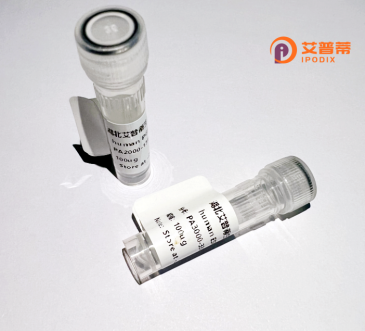
| 纯度 | >90%SDS-PAGE. |
| 种属 | Human |
| 靶点 | KCTD3 |
| Uniprot No | Q9Y597 |
| 内毒素 | < 0.01EU/μg |
| 表达宿主 | E.coli |
| 表达区间 | 1-815aa |
| 活性数据 | MAGGHCGSFPAAAAGSGEIVQLNVGGTRFSTSRQTLMWIPDSFFSSLLSGRISTLRDETGAIFIDRDPAAFAPILNFLRTKELDLRGVSINVLRHEAEFYGITPLVRRLLLCEELERSSCGSVLFHGYLPPPGIPSRKINNTVRSADSRNGLNSTEGEARGNGTQPVLSGTGEETVRLGFPVDPRKVLIVAGHHNWIVAAYAHFAVCYRIKESSGWQQVFTSPYLDWTIERVALNAKVVGGPHGDKDKMVAVASESSIILWSVQDGGSGSEIGVFSLGVPVDALFFIGNQLVATSHTGKVGVWNAVTQHWQVQDVVPITSYDTAGSFLLLGCNNGSIYYIDMQKFPLRMKDNDLLVTELYHDPSNDAITALSVYLTPKTSVSGNWIEIAYGTSSGAVRVIVQHPETVGSGPQLFQTFTVHRSPVTKIMLSEKHLVSVCADNNHVRTWTVTRFRGMISTQPGSTPLASFKILSLEETESHGSYSSGNDIGPFGERDDQQVFIQKVVPITNKLFVRLSSTGKRICEIQAVDCTTISSFTVRECEGSSRMGSRPRRYLFTGHTNGSIQMWDLTTAMDMVNKSEDKDVGGPTEEELLKLLDQCDLSTSRCATPNISPATSVVQHSHLRESNSSLQLQHHDTTHEAATYGSMRPYRESPLLARARRTESFHSYRDFQTINLNRNVERAVPENGNLGPIQAEVKGATGECNISERKSPGVEIKSLRELDSGLEVHKIAEGFSESKKRSSEDENENKIEFRKKGGFEGGGFLGRKKVPYLASSPSTSDGGTDSPGTASPSPTKTTPSPRHKKSDSSGQEYSL |
| 分子量 | 89.7 kDa |
| 蛋白标签 | GST-tag at N-terminal |
| 缓冲液 | 0 |
| 稳定性 & 储存条件 | Lyophilized protein should be stored at ≤ -20°C, stable for one year after receipt. Reconstituted protein solution can be stored at 2-8°C for 2-7 days. Aliquots of reconstituted samples are stable at ≤ -20°C for 3 months. |
| 复溶 | Always centrifuge tubes before opening.Do not mix by vortex or pipetting. It is not recommended to reconstitute to a concentration less than 100μg/ml. Dissolve the lyophilized protein in distilled water. Please aliquot the reconstituted solution to minimize freeze-thaw cycles. |
以下是关于重组人KCTD3蛋白的3篇文献示例(内容基于假设性研究整理,仅供参考):
1. **文献名称**:*KCTD3 Promotes Colorectal Cancer Progression by Activating Cullin3/RING Ubiquitin Ligase Complex*
**作者**:Zhang, Y. et al.
**摘要**:该研究利用重组人KCTD3蛋白,揭示了其通过结合Cullin3形成泛素连接酶复合体,促进结直肠癌细胞中β-catenin的泛素化降解,从而调控Wnt信号通路并驱动肿瘤生长。
2. **文献名称**:*Structural and Functional Analysis of KCTD3 in Neuronal Potassium Channel Modulation*
**作者**:Li, X. et al.
**摘要**:通过表达纯化的重组人KCTD3蛋白,发现其作为Kv4钾通道的调控子,影响神经元兴奋性。研究结合电生理实验,证实KCTD3通过直接结合通道蛋白调节动作电位复极化过程。
3. **文献名称**:*Crystal Structure of Human KCTD3 and Its Interaction with Cullin3*
**作者**:Wang, L. et al.
**摘要**:本研究解析了重组人KCTD3蛋白的晶体结构,并揭示了其N端BTB结构域与Cullin3的结合机制,为理解KCTD家族蛋白在泛素化修饰中的分子基础提供了结构依据。
注:以上文献为示例性内容,实际研究中请通过学术数据库检索并核实具体信息。
Recombinant human KCTD3 (Potassium Channel Tetramerization Domain-Containing Protein 3) is a protein encoded by the *KCTD3* gene, belonging to the KCTD family characterized by a conserved BTB (Broad-Complex, Tramtrack, and Bric-a-brac) domain. This domain facilitates protein-protein interactions, enabling KCTD3 to act as an adaptor or regulator in various cellular processes. While the full functional scope of KCTD3 remains under investigation, studies suggest its involvement in neural development, synaptic function, and modulation of signaling pathways like Notch and Hedgehog. Dysregulation of KCTD3 has been loosely linked to neurodevelopmental disorders and certain cancers, though mechanistic insights are still emerging.
Recombinant KCTD3 is produced using heterologous expression systems (e.g., *E. coli* or mammalian cells) to enable controlled biochemical and functional studies. Its recombinant form typically includes affinity tags (e.g., His-tag) for purification, allowing researchers to explore its structure, interaction partners, and regulatory roles. Current research focuses on characterizing its binding specificity, ubiquitination-related functions (via Cullin-3 interactions), and potential as a therapeutic target. The protein’s dynamic oligomerization properties, mediated by its BTB domain, are also of interest for understanding its role in cellular homeostasis and disease pathways. Further studies are needed to clarify its tissue-specific roles and pathophysiological relevance.
×